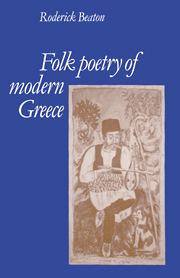Book contents
- Frontmatter
- Contents
- Preface
- Maps
- 1 INTRODUCTION
- 2 THE DEMOTIC TRADITION: THE SONGS
- 3 STRUCTURE OF THE DEMOTIC TRADITION: THE FORMULA
- 4 STRUCTURE OF THE DEMOTIC TRADITION: IMAGERY AND THEMES
- 5 THE EMERGENCE OF THE DEMOTIC TRADITION
- 6 FUNCTION OF THE DEMOTIC TRADITION: THE SONGS AND HISTORY
- 7 THE SONGS AS MYTH
- 8 ONE TRADITION OR SEVERAL?
- 9 THE HISTORICAL TRADITION
- 10 GREEK FOLK POETRY AND WRITING
- Notes
- Glossary of Greek words transliterated in the text
- Bibliography
- Index
4 - STRUCTURE OF THE DEMOTIC TRADITION: IMAGERY AND THEMES
Published online by Cambridge University Press: 13 September 2009
- Frontmatter
- Contents
- Preface
- Maps
- 1 INTRODUCTION
- 2 THE DEMOTIC TRADITION: THE SONGS
- 3 STRUCTURE OF THE DEMOTIC TRADITION: THE FORMULA
- 4 STRUCTURE OF THE DEMOTIC TRADITION: IMAGERY AND THEMES
- 5 THE EMERGENCE OF THE DEMOTIC TRADITION
- 6 FUNCTION OF THE DEMOTIC TRADITION: THE SONGS AND HISTORY
- 7 THE SONGS AS MYTH
- 8 ONE TRADITION OR SEVERAL?
- 9 THE HISTORICAL TRADITION
- 10 GREEK FOLK POETRY AND WRITING
- Notes
- Glossary of Greek words transliterated in the text
- Bibliography
- Index
Summary
IMAGERY
One of the most immediately striking features of almost any Greek folk song is the prominent role of imagery. In the majority of cases this imagery is neither merely decorative nor does it offer a pictorial representation of the natural world. Frequently the architectonic patterns of a song or the progress of a theme are worked out in terms of images, and these images often invoke the natural world as a reflection of human emotions or attributes, and also perhaps as an arbiter of order. Although many images of this sort tend to recur with predictable regularity and seem to fulfil fairly standard functions, the range and subtlety of detailed imagery which we find in the songs show that the ability to create and vary images must have been a highly prized aspect of the art of composing and singing. It is this ingenuity in handling imagery, and the ability to develop a lyrical theme almost entirely through images, that most readily distinguishes the demotic tradition of folk poetry in Greece.
This can be seen by comparing two poems, one from a popular religious text of the twelfth century, the other a folk lament.
̓Eμέν̓ οὐ πρἐπει νὰ λαλῶ, οὐδὲ νὰ ουντυχαίνω,
οὐ πρέπει ἐμὲν νὰ βλὲπωμαι, οὐδὲ πάλιν νὰ βλὲπω,
οὐδὲ νὰ τρέφωμαι τροφὴν τὴν πρέπουσαν ἀνθρώποις.
- Type
- Chapter
- Information
- Folk Poetry of Modern Greece , pp. 58 - 73Publisher: Cambridge University PressPrint publication year: 1980

